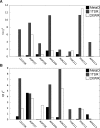DNA-binding protects p53 from interactions with cofactors involved in transcription-independent functions
- PMID: 27604871
- PMCID: PMC5100575
- DOI: 10.1093/nar/gkw770
DNA-binding protects p53 from interactions with cofactors involved in transcription-independent functions
Abstract
Binding-induced conformational changes of a protein at regions distant from the binding site may play crucial roles in protein function and regulation. The p53 tumour suppressor is an example of such an allosterically regulated protein. Little is known, however, about how DNA binding can affect distal sites for transcription factors. Furthermore, the molecular details of how a local perturbation is transmitted through a protein structure are generally elusive and occur on timescales hard to explore by simulations. Thus, we employed state-of-the-art enhanced sampling atomistic simulations to unveil DNA-induced effects on p53 structure and dynamics that modulate the recruitment of cofactors and the impact of phosphorylation at Ser215. We show that DNA interaction promotes a conformational change in a region 3 nm away from the DNA binding site. Specifically, binding to DNA increases the population of an occluded minor state at this distal site by more than 4-fold, whereas phosphorylation traps the protein in its major state. In the minor conformation, the interface of p53 that binds biological partners related to p53 transcription-independent functions is not accessible. Significantly, our study reveals a mechanism of DNA-mediated protection of p53 from interactions with partners involved in the p53 transcription-independent signalling. This also suggests that conformational dynamics is tightly related to p53 signalling.
© The Author(s) 2016. Published by Oxford University Press on behalf of Nucleic Acids Research.
Figures







Similar articles
-
Phosphorylation Regulates the Bound Structure of an Intrinsically Disordered Protein: The p53-TAZ2 Case.PLoS One. 2016 Jan 7;11(1):e0144284. doi: 10.1371/journal.pone.0144284. eCollection 2016. PLoS One. 2016. PMID: 26742101 Free PMC article.
-
Lysine120 interactions with p53 response elements can allosterically direct p53 organization.PLoS Comput Biol. 2010 Aug 5;6(8):e1000878. doi: 10.1371/journal.pcbi.1000878. PLoS Comput Biol. 2010. PMID: 20700496 Free PMC article.
-
Investigation of the impact of R273H and R273C mutations on the DNA binding domain of P53 protein through molecular dynamic simulation.J Biomol Struct Dyn. 2025 Feb;43(2):798-812. doi: 10.1080/07391102.2023.2283793. Epub 2023 Nov 21. J Biomol Struct Dyn. 2025. PMID: 39737749
-
Recognition of Local DNA Structures by p53 Protein.Int J Mol Sci. 2017 Feb 10;18(2):375. doi: 10.3390/ijms18020375. Int J Mol Sci. 2017. PMID: 28208646 Free PMC article. Review.
-
The Rich World of p53 DNA Binding Targets: The Role of DNA Structure.Int J Mol Sci. 2019 Nov 9;20(22):5605. doi: 10.3390/ijms20225605. Int J Mol Sci. 2019. PMID: 31717504 Free PMC article. Review.
Cited by
-
Use of Computational Biochemistry for Elucidating Molecular Mechanisms of Nitric Oxide Synthase.Comput Struct Biotechnol J. 2019 Mar 23;17:415-429. doi: 10.1016/j.csbj.2019.03.011. eCollection 2019. Comput Struct Biotechnol J. 2019. PMID: 30996821 Free PMC article. Review.
-
Hidden electrostatic energy contributions define dynamic allosteric communications within p53 during molecular recognition.Biophys J. 2021 Oct 19;120(20):4512-4524. doi: 10.1016/j.bpj.2021.08.037. Epub 2021 Sep 1. Biophys J. 2021. PMID: 34478701 Free PMC article.
-
Looking at Biomolecular Interactions through the Lens of Correlated Fluorescence Microscopy and Optical Tweezers.Int J Mol Sci. 2023 Jan 31;24(3):2668. doi: 10.3390/ijms24032668. Int J Mol Sci. 2023. PMID: 36768987 Free PMC article. Review.
-
Sequence Properties of An Intramolecular Interaction That Inhibits p53 DNA Binding.Biomolecules. 2022 Oct 25;12(11):1558. doi: 10.3390/biom12111558. Biomolecules. 2022. PMID: 36358908 Free PMC article.
-
Changes in the free-energy landscape of p38α MAP kinase through its canonical activation and binding events as studied by enhanced molecular dynamics simulations.Elife. 2017 Apr 26;6:e22175. doi: 10.7554/eLife.22175. Elife. 2017. PMID: 28445123 Free PMC article.
References
-
- Changeux J.-P. Allostery and the Monod-Wyman-Changeux model after 50 years. Annu. Rev. Biophys. 2012;41:103–133. - PubMed
-
- Ribeiro A.A.S.T., Ortiz V. A chemical perspective on allostery. Chem. Rev. 2016;116:6488–6502. - PubMed
-
- Papaleo E., Saladino G., Lambrughi M., Lindorff-Larsen K., Gervasio F.L., Nussinov R. The role of protein loops and linkers in conformational dynamics and allostery. Chem. Rev. 2016;116:6391–6423. - PubMed
MeSH terms
Substances
Grants and funding
LinkOut - more resources
Full Text Sources
Other Literature Sources
Molecular Biology Databases
Research Materials
Miscellaneous

